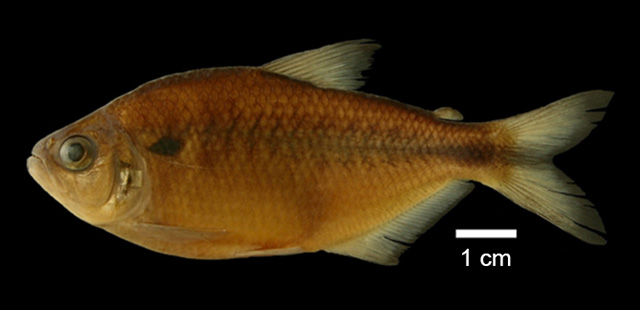| Characidae (Characins; tetras), subfamily: Stethaprioninae |
| 8.95 cm SL (male/unsexed) |
|
benthopelagic; freshwater |
| South America: Upper Amazon River Basin of Bolivia and Peru. |
|
Dorsal soft rays (total): 9-9. This species which is a member of the orthodus species-group of Astyanax differs from other species of the group in having lines extending from the tips of the chevrons on both the anterior and posterior extremes (proximal and distal sections of chevron extensions), forming etensions between the chevrons (vs. chevrons without lines extending from their tips), except A. moorii which is distinguished by the number of lateral-line scales 39-42 (vs. 44–50); also differs from A. moorii in the upper jaw length > 34% HL (vs. < 47% HL); further differs from A. villwocki by the absence of a dark stripe on the sides of the body (vs. with dark lateral stripe or anterior prolongation of the caudal peduncle spot extending over the silvery lateral stripe); differs from orthodus, embera, yariguies in having a distinct rhomboidal caudal-peduncle spot with a short, anterior, prolongation that does not surpass a vertical through the anal-fin origin (vs. spot on caudal peduncle a short polygon shape not surpassing the posterior tip of the anal fin in orthodus, embera and spot on caudal peduncle elongated as a stripe, continuing anteriorly to humeral region in A. villwocki; differs from A. bopiensis in having , 4 teeth extending over less than one third of the maxillary (vs. > 5 teeth extending over more than two thirds of the maxillary) (Ref. 119406). |
|
|
Not Evaluated (N.E.) Ref. (130435)
|
| harmless |
Source and more info: www.fishbase.org. For personal, classroom, and other internal use only. Not for publication.

